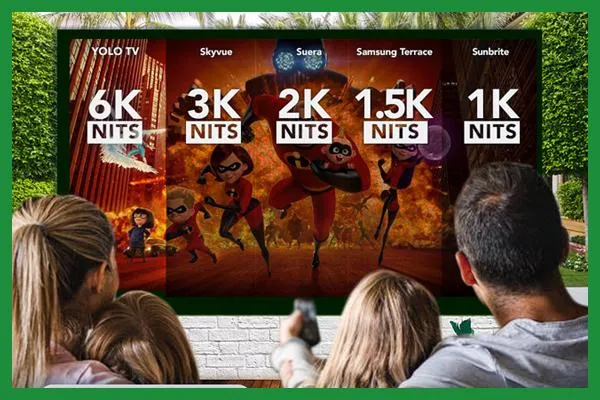YOLO TV Learning Center
YOLO TV Learning Center

The Importance of 5000 Nits for Outdoor TV Viewing
When selecting an outdoor TV, brightness is a crucial factor, measured in nits. A standard nit level is essential for direct sunlight viewing to ensure clear and vibrant images. This blog will explore the significance of brightness in outdoor TVs, explicitly focusing on why 5000 nits are the standard for optimal viewing in direct sunlight.
What are Nits?
Nits are a unit of measurement for the brightness or luminance of a display, with one nit equaling one candela per square meter (cd/m²). The higher the nit value, the brighter the screen, which is vital for outdoor TVs to remain visible in bright ambient light conditions.
The Importance of Brightness in Outdoor TVs
Outdoor TVs, like YOLO TV, compete with natural sunlight, which can wash out the screen. A display with a higher nit level, such as 5000 nits, effectively combats this issue, ensuring clear and visible images even in bright environments. This is particularly important when using an outdoor TV enclosure, as it adds an extra layer of protection without compromising visibility.
Comparison of Brightness Level of Outdoor TV brands
Difference between an indoor tv and Patio outdoor TV. #outdoortv #Samsungterrace #Sunbrite from Theater Advice
In this comparison video by Theater Advice, a reputable audio-video company in the Dallas/Fort Worth area, the difference in brightness between two outdoor TVs, Sunbrite TV and Samsung Terrace TV, is showcased. The video highlights the difficulties of viewing the Samsung Terrace TV, particularly under a covered patio, due to its lackluster brightness and pronounced glare.
Brightness and glare are crucial factors that distinguish YOLO TVs. With a brightness of over 5000 nits and zero glare, they ensure crisp and vivid colors for an unparalleled viewing experience from any angle and at any time of day or night.
Standard Nit Levels for Direct Sunlight Viewing
For optimal viewing in direct sunlight, outdoor TVs should have a brightness level of around 5000 nits. This ensures the screen remains visible and readable in bright, sunny conditions. The specific nit requirement may vary based on the application and location of the display.
Inputech - High Brightness Displays Comparison 1'500 - 5'000 nits from Inputech
This video by Inputech, though several years old, remains the best real-life comparison of nit brightness levels available, serving as a valuable resource for one of the most important elements of outdoor TV comparison. Despite the glare caused by their glass enclosures, these TVs clearly demonstrate what you can expect when purchasing TVs with nit ratings below 5000.
Factors Influencing Required Nit Levels
1. Ambient Light: The brighter the surroundings, the higher the nit level needed for visibility.
2. Screen Size: The larger the screen size, the higher the nit levels to maintain uniform brightness.
3. Viewing Distance: The screen may need to be brighter the further away the viewer is.
4. Content Type: High-contrast content is more visible at lower nit levels compared to low-contrast content.
So Which Outdoor TV Offers the Best Brightness?
In summary, when choosing an outdoor TV, it's crucial to consider a standard nit brightness of 5000 nits for direct sunlight viewing. This level of brightness, as seen in YOLO TV, ensures clear and visible images in bright outdoor conditions. Understanding the importance of nits and the factors that influence required brightness levels allows for an informed decision that ensures optimal viewing experiences in any outdoor setting. If you would like to learn more about our outdoor TVs, indoor TVs, or TV rise stands, contact us today!
Related Articles:

Get the latest, most relevant news from YOLO TV!








